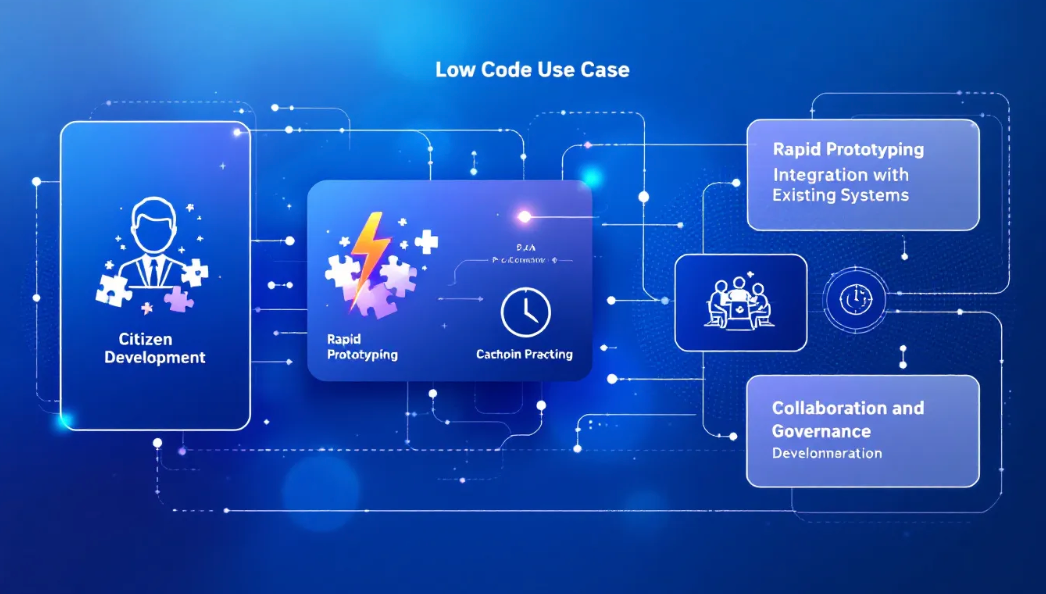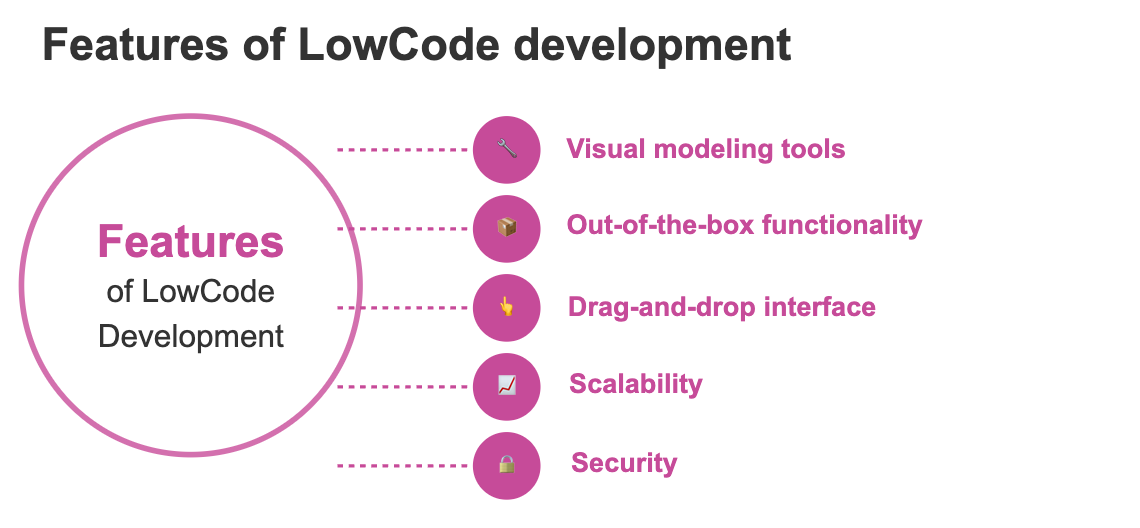

Essential LowCode Development Platform Statistics and Trends Driving Digital Innovation in 2025
Publié le 25 mars 2025
Écrit par Jaren Hidalgo - 11 minutes de lecture
LowCode development platforms help you build apps faster with minimal coding. Using visual tools like drag-and-drop interfaces, they simplify the process for both developers and non-programmers. This article explores the key trends and statistics shaping LowCode development in 2025.
Principaux enseignements
LowCode development platforms enable rapid application creation with minimal coding, fostering collaboration between IT and business teams for more aligned solutions.
The LowCode market is booming, with a projected growth to approximately $388.6 billion by 2030, offering substantial ROI for businesses adopting these platforms, according to a report by Global Industry Analysts, Inc., published in February 2025.
Les développeurs citoyens sont en plein essor : selon l'analyse de Gartner, ils devraient être plus nombreux que les développeurs professionnels d'ici à la fin de 2025, ce qui favorisera l'innovation et l'autonomie au sein des organisations grâce à des outils de développement d'applications accessibles.
What is a LowCode Development Platform?

At its core, a LowCode development platform is a software solution that enables users to create applications with minimal hand-coding. Leveraging graphical interfaces and pre-built templates, these platforms simplify app development, making it accessible to both developers and non-programmers.
LowCode platforms transform the development landscape by centralizing LowCode application development, testing, and deployment. This approach not only accelerates innovation but also reduces the dependency on IT teams, allowing businesses to respond more swiftly to market changes. LowCode adoption shifts coding from a text-based to a visual approach, using model-driven, drag-and-drop interfaces to streamline LowCode development and utilize a LowCode development platform.
Moreover, LowCode platforms foster collaboration between IT and business departments, promoting a stronger partnership that aligns technological solutions with business goals. Whether it’s process automation, digitizing operations, or managing requests, LowCode development offers flexible solutions that can be tailored to specific business needs.
Key Benefits of LowCode Platforms

A major benefit of LowCode platforms is their ability to drastically reduce development times. Applications that once took months to build can now be completed in days or weeks, empowering organizations to respond swiftly to market demands and customer needs. The accelerated development cycle enhances productivity and offers significant cost savings when scaled across multiple applications.
LowCode platforms also democratize LowCode app development by enabling non-technical employees to create tailored solutions rapidly. This feature boosts workforce productivity, allowing developers to concentrate on more critical projects. The intuitive graphical interface of a LowCode platform simplifies designing and modifying applications, keeping them current and relevant. Additionally, LowCode development platforms enhance collaboration across teams.
Further, organizations that adopt LowCode platforms for customer-facing applications often see a significant increase in revenue. Companies report an average 58% boost in revenue, highlighting the tangible business value these platforms offer. With LowCode, businesses build solutions 56% faster than those using traditional development technologies, underscoring the efficiency and effectiveness of this innovative approach.
Croissance du marché et impact économique
The LowCode development market is experiencing explosive growth. With a compound annual growth rate (CAGR) of 37.9% from 2023 to 2030, the market is projected to grow from approximately $41 billion in 2023 to a staggering $388.6 billion by 2030, as cited in an article by ManageEngine.This rapid growth underscores the rising recognition of LowCode platforms as vital tools for digital transformation.
Economically, the return on investment (ROI) for companies leveraging LowCode platforms is substantial. According to an IDC study commissioned by Appian, organizations can expect an average ROI of 509% within five years due to reduced development costs and more affordable application building.
According to findings from Forrester Research, companies adopting LowCode solutions can expect potential business value gains of approximately $4.4 million over three years. This underscores the significant financial benefits associated with this technological shift, as organizations leverage LowCode platforms to streamline processes and enhance operational efficiency.
Popular Use Cases for LowCode Platforms

LowCode platforms demonstrate versatility across various industries. In sectors like financial services, healthcare, and manufacturing, these platforms are being leveraged to develop a wide range of applications, from supply chain management systems to B2C mobile apps. Supply chain management apps built with LowCode platforms provide real-time updates and inventory tracking, enhancing operational efficiency.
In the realm of IoT, LowCode platforms streamline device integration, enabling efficient data management and analysis. This feature is essential for industries that depend on real-time data for decision-making. LowCode platforms also enable the creation of self-service customer portals, allowing users to handle tasks independently and enhancing the user experience.
Schneider Electric exemplifies the rapid development capabilities of LowCode platforms, launching 60 apps in just 10 weeks, as sourced from OutSystems' case study.This case study showcases how these platforms can drastically reduce development time and enable businesses to quickly adapt to changing market conditions. The collaborative nature of LowCode also bridges the gap between IT and other departments, ensuring better alignment with business goals.
Essential Features of LowCode Development Platforms

LowCode tools development platforms are packed with features that make app creation more accessible and efficient. Key among these are visual interfaces, basic logic, and drag-and-drop capabilities that facilitate the app creation process.
Ils utilisent également des composants modulaires pré-testés pour faciliter la maintenance et l'intégration, garantissant ainsi des applications évolutives et agiles.
Outils de modélisation visuelle
Visual modeling tools are fundamental to LowCode platforms, allowing users to create applications by visually assembling components. This method removes the need for deep programming skills, making development accessible to a wider range of users. Users can dynamically build forms using user-based control. They also have access to ready-to-use widgets, which simplifies the app creation process.
Ces outils permettent de simuler les flux de travail de l'application avant le début du développement proprement dit, en fournissant une représentation visuelle plus facile à comprendre et à modifier. Cette fonctionnalité améliore la collaboration entre les services informatiques et les utilisateurs professionnels, garantissant ainsi que le produit final est conforme aux objectifs de l'entreprise.
Interface Glisser-Déposer
Une autre caractéristique essentielle est l'interface "glisser-déposer", qui réduit considérablement les obstacles techniques au développement d'applications. Elle permet aux utilisateurs de construire des interfaces d'application de manière intuitive, ce qui les rend accessibles même à ceux qui n'ont qu'une expérience technique minimale. En arrangeant visuellement les éléments sans écrire de code, les utilisateurs peuvent rapidement concevoir et modifier les applications, ce qui garantit un processus de développement plus agile. La fonctionnalité "glisser-déposer" améliore encore cette expérience.
Cette interface rationalise la conception des applications et permet aux utilisateurs non techniques de participer activement au développement. Cette inclusivité favorise un environnement plus collaboratif dans lequel les acteurs de l'entreprise peuvent contribuer directement au processus de développement, ce qui garantit que l'application finale répond plus efficacement aux besoins de l'entreprise.
Fonctionnalité prête à l'emploi
Les fonctionnalités prêtes à l'emploi comprennent des composants et des modèles prédéfinis qui facilitent le développement rapide d'applications. Ces éléments automatisent les tâches répétitives, ce qui permet aux utilisateurs de se concentrer sur les aspects plus complexes et créatifs du développement. Cette fonctionnalité est particulièrement utile pour les entreprises qui souhaitent déployer des applications rapidement sans compromettre la qualité.
Les fonctions de développement visuel et les composants pré-testés garantissent des applications robustes et évolutives, répondant aux divers besoins des entreprises. En tirant parti de ces éléments prêts à l'emploi, les entreprises peuvent réduire considérablement le temps et les efforts nécessaires à la mise sur le marché de nouvelles applications.
Challenges and Limitations of LowCode Platforms

Despite their numerous benefits, LowCode platforms are not without challenges. One significant issue is vendor lock-in, which can limit a company’s flexibility to switch platforms, potentially hindering security and integration capabilities. A chosen LowCode platform must offer robust security features like data encryption and user access controls for safe application creation.
Scalability is another concern, as many LowCode platforms struggle to handle significant data volumes and complex requirements. Applications built using LowCode platforms may not always match the performance and scalability of those developed through traditional coding methods, posing a challenge for complex business needs.
Integration with legacy systems can also be problematic, requiring careful consideration of the platform’s integration capabilities. Customization limitations and unpredictable pricing models further complicate the adoption process, making it essential for organizations to thoroughly evaluate their needs and the capabilities of the LowCode solutions they consider.
Comparing LowCode vs. Traditional Development
Comparing LowCode platforms to traditional development methods reveals striking differences in speed, cost, and flexibility. LowCode platforms can reduce development times from months to weeks, offering a significant advantage in today’s fast-paced business environment. Rapid development capability allows for quick modifications and error corrections, making LowCode solutions more agile than traditional methods.
Additionally, LowCode platforms enable organizations to break down monolithic applications into more manageable microservices, improving flexibility and security. Building applications ten times faster than traditional methods underscores the efficiency of LowCode platforms.
Le rôle des développeurs citoyens
One of the most exciting trends in LowCode development is the rise of citizen developers. By the end of 2025, the number of citizen developers is predicted to surpass professional developers by a ratio of 4 to 1, highlighting the growing accessibility of app development. These non-IT professionals are empowered to create IT products and services using LowCode tools, fostering greater self-sufficiency within business units and enhancing innovation.
LowCode platforms often include collaboration tools that enhance communication between stakeholders and developers, making the development process more inclusive and efficient. This collaborative environment ensures that the final applications align closely with business goals, leveraging the unique insights of both professional developers and citizen developers.
How to Choose the Right LowCode Platform
Selecting the right LowCode platform requires a thorough understanding of your organization’s specific needs and goals. From identifying the types of applications you plan to develop to considering essential features like visual modeling tools and drag-and-drop interfaces, a well-rounded evaluation is crucial.
Évaluer vos besoins
Understanding your organization’s needs is the first step in selecting the right LowCode platform. Identify the types of applications you plan to develop and the features most important to your process, such as visual modeling tools and drag-and-drop interfaces. These features simplify app design and make the development process accessible to non-technical users, ensuring that the platform meets the needs of all stakeholders.
En outre, tenez compte des fonctionnalités prêtes à l'emploi fournies par la plateforme. Les composants et les modèles préconstruits peuvent accélérer considérablement le déploiement, ce qui permet à votre équipe de se concentrer sur les aspects plus complexes et créatifs du développement de l'application.
Un solide écosystème d'intégration garantit que la plateforme peut fonctionner de manière transparente avec les systèmes existants, ce qui permet de maximiser les investissements technologiques.
Critères de sélection clés
When choosing a LowCode platform, consider key criteria that facilitate collaboration between IT and business teams. A good platform should provide different interfaces for each group, ensuring that both technical and non-technical users can contribute effectively to the development process.
Cette approche favorise un environnement de développement plus inclusif et plus souple, en alignant les solutions technologiques sur les objectifs de l'entreprise.
Comparaison des fournisseurs
Comparing vendors is crucial in selecting the most suitable LowCode platform for your organization. Evaluations should cover features, pricing structures, and user feedback to identify the strengths and weaknesses of different platforms. Thorough comparisons empower organizations to make informed decisions that align with development needs and budget constraints.
Criteria such as features and user feedback highlight each platform’s unique advantages and potential drawbacks. By conducting a detailed vendor comparison, organizations can ensure they choose a LowCode platform that meets their specific requirements and supports their long-term digital transformation goals.
Future Trends in LowCode Development

The future of LowCode development looks bright, with several trends expected to shape the landscape. One of the most significant trends is the increasing integration of AI and cloud technologies into LowCode platforms. These advancements are enhancing the capabilities of LowCode solutions, making them applicable for more complex applications and driving greater adoption among businesses.
Digital transformation continues as a primary motivator behind LowCode adoption, with 66% of organizations citing it as their main driver. As more companies recognize the benefits of LowCode platforms, such as reduced development times and cost savings, market growth is expected to continue.
LowCode development is anticipated to expand both as a social and technical phenomenon, further solidifying its role in the software development landscape.
Résumé
In summary, LowCode development platforms are revolutionizing the way businesses approach app development. With their ability to reduce development times, lower costs, and empower non-technical users, these platforms are driving digital transformation across various industries. The market for LowCode solutions is growing rapidly, and organizations that adopt these platforms are seeing substantial economic benefits.
As we look to the future, the integration of AI and cloud technologies, along with the rise of citizen developers, will continue to shape the LowCode landscape. By partnering with experts like Kreante, businesses can leverage the full potential of LowCode platforms to stay competitive and innovate rapidly in today’s digital age. Embrace the LowCode revolution and transform your business operations for a more agile and efficient future. For more insights and updates on LowCode development, be sure to visit our blog and stay informed about the latest trends and strategies in digital transformation.
Partner with Kreante for Your LowCode Journey
At Kreante, we help organizations harness the full potential of LowCode development platforms. Our team of experts combines deep technical knowledge with strategic business insights to guide your digital transformation initiatives. Whether you’re looking to accelerate app development, empower citizen developers, or modernize legacy systems, our proven methodology ensures you achieve measurable results with LowCode technologies.
Ready to transform your business with LowCode solutions? Contact our team to schedule a consultation and learn how Kreante can help you achieve your digital goals with minimal reliance on traditional coding. Our approach enables developers at all skill levels to contribute effectively while meeting your unique business needs.
Questions fréquemment posées
What is a LowCode development platform?
A LowCode development platform empowers you to create apps easily with its user-friendly graphical interfaces and pre-built templates, allowing for faster development without extensive coding skills. It's a fantastic way to bring your ideas to life effortlessly!
What are the key benefits of LowCode platforms?
LowCode platforms significantly reduce development time and costs while boosting productivity, empowering even non-technical users to create applications effortlessly. Embracing this technology can lead to innovative solutions and an enhanced workflow.
What are some popular use cases for LowCode platforms?
LowCode platforms are highly versatile, commonly used for supply chain management, B2C mobile applications, self-service customer portals, and IoT device integration. These applications empower businesses to innovate quickly and efficiently!
What challenges do LowCode platforms face?
LowCode platforms face challenges like vendor lock-in and integration difficulties, but with the right approach and development team, you can navigate these obstacles to harness their full potential!
How do I choose the right LowCode platform for my organization?
To choose the right LowCode platform for your organization, focus on evaluating your specific needs, prioritizing integration capabilities and pricing. By comparing vendors based on features and user feedback, you'll make a well-informed decision that supports your goals.

Accélérer le développement de logiciels avec Vibe Coding et les outils d'IA chez Kreante

Kreante: Accelerating Your AppDevelopment with Low-Code, AI, and “Vibecoding”




.png)
